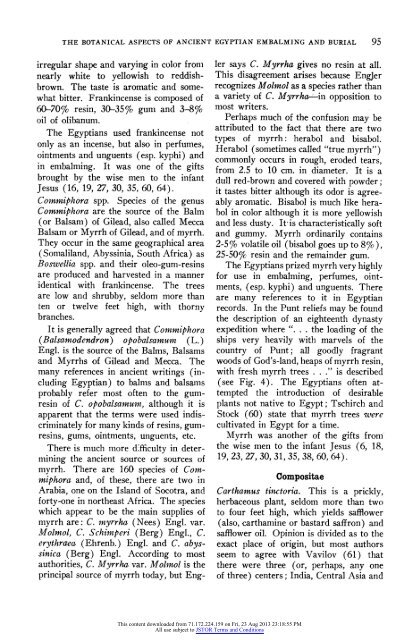The Botanical Aspects of Ancient Egyptian Embalming and Burial
The Botanical Aspects of Ancient Egyptian Embalming and Burial
The Botanical Aspects of Ancient Egyptian Embalming and Burial
You also want an ePaper? Increase the reach of your titles
YUMPU automatically turns print PDFs into web optimized ePapers that Google loves.
THE BOTANICAL ASPECTS OF ANCIENTr EGYPTIAN EMBALMING AND BURIAL 95<br />
irregular shape <strong>and</strong> varying in color from<br />
nearly white to yellowish to reddishbrown.<br />
<strong>The</strong> taste is aromatic <strong>and</strong> somewhat<br />
bitter. Frankincense is composed <strong>of</strong><br />
60-70% resin, 30-35% gum <strong>and</strong> 3-8%o<br />
oil <strong>of</strong> olibanum.<br />
<strong>The</strong> <strong>Egyptian</strong>s used frankincense not<br />
only as an incense, but also in perfumes,<br />
ointments <strong>and</strong> unguents (esp. kyphi) <strong>and</strong><br />
in embalming. It was one <strong>of</strong> the gifts<br />
brought by the wise men to the infant<br />
Jesus (16, 19, 27, 30, 35, 60, 64).<br />
Commiphora spp. Species <strong>of</strong> the genus<br />
Commiphora are the source <strong>of</strong> the Balm<br />
(or Balsam) <strong>of</strong> Gilead, also called Mecca<br />
Balsam or Myrrh <strong>of</strong> Gilead, <strong>and</strong> <strong>of</strong> myrrh.<br />
<strong>The</strong>y occur in the same geographical area<br />
(Somalil<strong>and</strong>, Abyssinia, South Africa) as<br />
Boswellia spp. <strong>and</strong> their oleo-gum-resins<br />
are produced <strong>and</strong> harvested in a manner<br />
identical with frankincense. <strong>The</strong> trees<br />
are low <strong>and</strong> shrubby, seldom more than<br />
ten or twelve feet high, with thorny<br />
branches.<br />
It is generally agreed that Commiphora<br />
(Balsamodendron) opobalsamum (L.)<br />
Engl. is the source <strong>of</strong> the Balms, Balsams<br />
<strong>and</strong> Myrrhs <strong>of</strong> Gilead <strong>and</strong> Mecca. <strong>The</strong><br />
many references in ancient writings (including<br />
<strong>Egyptian</strong>) to balms <strong>and</strong> balsams<br />
probably refer most <strong>of</strong>ten to the gumresin<br />
<strong>of</strong> C. opobalsamum, although it is<br />
apparent that the terms were used indiscriminately<br />
for many kinds <strong>of</strong> resins, gumresins,<br />
gums, ointments, unguents, etc.<br />
<strong>The</strong>re is much more d7fficulty in determining<br />
the ancient source or sources <strong>of</strong><br />
myrrh. <strong>The</strong>re are 160 species <strong>of</strong> Commiphora<br />
<strong>and</strong>, <strong>of</strong> these, there are two in<br />
Arabia, one on the Isl<strong>and</strong> <strong>of</strong> Socotra, <strong>and</strong><br />
forty-one in northeast Africa. <strong>The</strong> species<br />
which appear to be the main supplies <strong>of</strong><br />
myrrh are: C. mnyrrha (Nees) Engl. var.<br />
Molmol, C. Schimperi (Berg) Engl., C.<br />
erythraea (Ehrenb.) Engl. <strong>and</strong> C. abyssinica<br />
(Berg) Engl. According to most<br />
authorities, C. Myrrha var. Molmol is the<br />
principal source <strong>of</strong> myrrh today, but Eng-<br />
ler says C. Myrrha gives no resin at all.<br />
This disagreement arises because Engler<br />
recognizes Molmol as a species rather than<br />
a variety <strong>of</strong> C. Myrrha-in opposition to<br />
most writers.<br />
Perhaps much <strong>of</strong> the confusion may be<br />
attributed to the fact that there are two<br />
types <strong>of</strong> myrrh: herabol <strong>and</strong> bisabol.<br />
Herabol (sometimes called "true myrrh")<br />
commonly occurs in rough, eroded tears,<br />
from 2.5 to 10 cm. in diameter. It is a<br />
dull red-brown <strong>and</strong> covered with powder;<br />
it tastes bitter although its odor is agreeably<br />
aromatic. Bisabol is much like herabol<br />
in color although it is more yellowish<br />
<strong>and</strong> less dusty. It is characteristically s<strong>of</strong>t<br />
<strong>and</strong> gummy. Myrrh ordinarily contains<br />
2-5%o volatile oil (bisabol goes up to 8%o),<br />
25-50% resin <strong>and</strong> the remainder gum.<br />
<strong>The</strong> <strong>Egyptian</strong>s prized myrrh very highly<br />
for use in embalming, perfumes, ointments,<br />
(esp. kyphi) <strong>and</strong> unguents. <strong>The</strong>re<br />
are many references to it in <strong>Egyptian</strong><br />
records. In the Punt reliefs may be found<br />
the description <strong>of</strong> an eighteenth dynasty<br />
expedition where ". . . the loading <strong>of</strong> the<br />
ships very heavily with marvels <strong>of</strong> the<br />
country <strong>of</strong> Punt; all goodly fragrant<br />
woods <strong>of</strong> God's-l<strong>and</strong>, heaps <strong>of</strong> myrrh resin,<br />
with fresh myrrh trees . . ." is described<br />
(see Fig. 4). <strong>The</strong> <strong>Egyptian</strong>s <strong>of</strong>ten attempted<br />
the introduction <strong>of</strong> desirable<br />
plants not native to Egypt; Tschirch <strong>and</strong><br />
Stock (60) state that myrrh trees were<br />
cultivated in Egypt for a time.<br />
Myrrh was another <strong>of</strong> the gifts from<br />
the wise men to the infant Jesus (6, 18,<br />
19, 23, 27, 30, 31, 35, 38, 60,64).<br />
Compositae<br />
Carthamus tinctoria. This is a prickly,<br />
herbaceous plant, seldom more than two<br />
to four feet high, which yields safflower<br />
(also, carthamine or bastard saffron) <strong>and</strong><br />
safflower oil. Opinion is divided as to the<br />
exact place <strong>of</strong> origin, but most authors<br />
seem to agree with Vavilov (61) that<br />
there were three (or, perhaps, any one<br />
<strong>of</strong> three) centers; India, Central Asia <strong>and</strong><br />
This content downloaded from 71.172.224.159 on Fri, 23 Aug 2013 23:18:55 PM<br />
All use subject to JSTOR Terms <strong>and</strong> Conditions
















